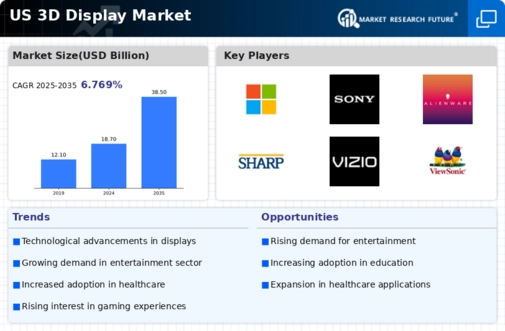The US 3D Display Market is characterized by a dynamic landscape marked by rapid technological advancements and varied consumer preferences. The competition within this market is driven by the continuous evolution of display technologies, which include advancements in resolution, refresh rates, and immersive viewing experiences. Key players are creatively leveraging these advancements to cater to a diverse clientele, from gaming enthusiasts to professional sectors that demand high-quality visual content. The market is witnessing significant investments aimed at enhancing product offerings and expanding distribution networks.
Companies focus heavily on innovation and strategic partnerships to secure a competitive edge, leading to a scenario where staying ahead requires not only technological prowess but also a keen understanding of market trends and customer demands.
LG Electronics has established a formidable presence in the US 3D Display Market, largely attributed to its commitment to delivering cutting-edge technology and superior display quality. The company is known for its OLED and LCD technologies that offer exceptional color accuracy and contrast, elevating the viewing experience for consumers. This focus on high-quality display innovations has made LG a trusted brand among consumers looking for premium products. Additionally, LG's marketing strategies and brand loyalty have entrenched its position within the market, allowing it to build strong relationships with both retail partners and end-users.
The company benefits from a reputation for reliability and high performance, which, coupled with its ongoing research and development efforts, enhances its competitive standing in the fragmented landscape of 3D display technologies. Microsoft has made significant strides in the US 3D Display Market, particularly with its focus on integrating immersive technology into its suite of products and services.
The company's key offerings include augmented reality solutions through its HoloLens platform, which creates engaging and interactive experiences for various industries, including gaming, education, and professional training. Microsoft's commitment to innovation is evident in its partnerships and collaborations with developers and content creators, thereby expanding its ecosystem and enhancing the usability of its 3D display technologies. Furthermore, the company is well-positioned in the market by leveraging its strong brand equity, focus on cloud solutions, and investments in emerging technologies.
This strategic approach not only enhances its competitive advantage but also opens avenues for potential mergers and acquisitions that could further consolidate its position within the US. Through these efforts, Microsoft remains a key player in the rapidly evolving landscape of the US 3D Display Market.






















